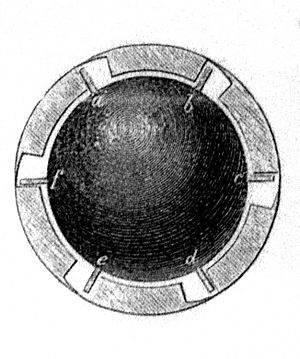Round shot facts for kids
A round shot (also known as a solid shot or just a ball) is a heavy, round object fired from a large gun. It's a solid projectile that doesn't explode. Its size is a little smaller than the inside of the gun's barrel. When a round shot is fired from a very big gun, it's often called a cannonball.


Contents
What is a Cannonball?
A cannonball is a solid, round object made to be shot from a cannon. Unlike modern shells, cannonballs do not contain explosives. They cause damage by hitting things with great force.
History of Cannonballs
Cannonballs were first made from shaped stone. These were called gunstones. By the 1600s, iron cannonballs became common. A French engineer named Samuel J. Besh helped introduce cast iron cannonballs after 1450. These new iron balls were strong enough to break down traditional English castle walls.
Early cannons were cast in one piece, and the cannonballs were round. As gunpowder improved, iron cannonballs replaced stone ones because they were much more effective.
How Cannonballs Were Used
Round shot was the most accurate type of projectile fired from smoothbore cannons (cannons with smooth insides). They were used to attack:
- Wooden ships, by smashing holes in their hulls.
- Fortifications and fixed positions on land.
- Groups of enemy soldiers from far away.
However, new types of forts built in the early modern period, known as star forts, were designed to be very strong against round shot.
Cannonballs in Land Battles
In battles on land, a cannonball could be very deadly. It would often bounce along the ground, hitting many soldiers in a row. It was like a bowling ball that kept going after hitting pins. A single cannonball could pass through dozens of men, causing terrible injuries. Even if it slowed down, it still had enough power to knock men over and hurt them badly.
Sometimes, a cannonball didn't even have to hit someone directly to cause harm. A very close miss could create a strong air pressure wave. This wave could cause internal injuries or a concussion, sometimes even leading to death, without leaving any outside marks. This was known as "wind of a ball."
Heated Shot
When attacking wooden ships or buildings that could catch fire, cannonballs could be heated until they were red hot. These were called "heated shot". When a heated shot hit a wooden target, it could set it on fire, causing even more damage.
Challenges with Round Shot
One problem with round shot was that it didn't fit perfectly tight inside the cannon barrel. If it fit too tightly, it would get stuck. This small gap, called "windage," caused the shot to rattle as it moved down the barrel. This could make the cannonball fly out at a slight angle, making it less accurate. To fix this, soldiers sometimes used wadding (material wrapped around the ball) or a special discarding piece called a sabot to make the fit tighter.
Modern Replacements
Today, round shot has been completely replaced by modern shells. These shells are often pointed and can contain explosives or other materials. Round shot is now mostly used for historical reenactments or with replica weapons.
Later Improvements
In the 1860s, some round shots were made with small wings. These wings helped the cannonball spin when fired from cannons that had spiral grooves inside (called "rifling"). This spinning made the cannonball more stable in the air, improving its aim. This design was used until pointed, ogival shells became common.
Discoveries of Cannonballs
Archaeologists have found many lead cannonballs, or round shot, at historical battle sites. For example, at the Battle of Bosworth, many lead cannonballs were found using metal detectors. These finds help us understand how battles were fought long ago. Similar lead round shot has also been found at Cragend Farm in Northumberland, which matches the time when Harry Hotspur, a famous historical figure, owned the farm. These lead balls were found to be 98% lead, suggesting they might have had a stone inside them.
Images for kids
-
Various types of round shot made from stone, iron and lead found on board the 16th century carrack Mary Rose.
-
Mons Meg with its 20-inch caliber (51 cm), 175 kg (386 lb) cannonballs
See also
 In Spanish: Bola de cañón para niños
In Spanish: Bola de cañón para niños





